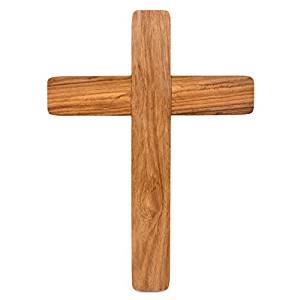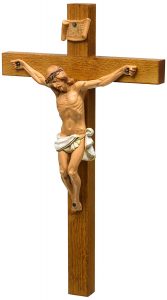(A letter Steve wrote to an Evangelical friend asking for an explanation of the Crucifix)
Dear Protestant Friend:

-
Save
I will start with the Old Testament and the Jews’ use of images and prohibition of idols. I know in advance that it is not a thorough study, but it will give a general overview of the issues. I will try to provide a brief overview of the Cross and the Crucifix, the origin, the history, and the differing perspectives of Catholic and Protestant. It will try to catch the historical flow and include the pertinent points. The outline is as follows:
The Three Main Protestant Objections to the Crucifix
Let me begin by defining “Protestant” as used in this article. First, it is used to describe the first Reformers who tore down crucifixes and crosses in the first years of the Reformation; and second, it refers to general American Evangelical-type Protestants. Granted there are many Anglican and “high” Lutherans and others that do not object to the crucifix or other Christian symbolism. With that behind us, let’s begin.

-
Save
Second, Protestants see the image of Christ on the cross as a violation of the command to make no graven image. The Reformers were big on this. Protestants now utilize plain crosses in their “churches,” on their walls, and around their necks, just as they have pictures of Jesus (always with soft skin and melodrama) on their walls. (I was raised with this feminine Jesus presiding, ever so romantically, over our dinner table.
After spending time in the Holy Land, driving through the Judean wilderness, and ascending Mount Tabor, which he and his disciples frequented, I doubt he was so dainty and delicate; he probably had calves like a bear and smelled a bit like one as well.) However, at the turn of the last century, the Protestant churches (excluding Lutheran) were still pretty much opposed to displaying of the cross, even the bare cross. The bare cross was not in wide use until recently, though current Protestants don’t know their own history on the matter and that their predecessors opposed it as much as they did the Crucifix.
Third, they object to the Crucifix because it is Catholic and to condone or display the Crucifix is to make a statement in favor of Catholicism. No one of “Reformed” persuasion would want to be identified as a Catholic. A bare cross seems to be generic, which is what most Protestants like–generic Christianity–with no history to criticize or Church to obey.
Images and Gods in the Old Testament
Since the people in olden ages worshiped idols made of earthly materials [Endnote 1], God forbade the children of Israel to possess such “gods”. “Then God spoke all these words, saying, “I am the Lord your God, who brought you out of the land of Egypt, out of the house of slavery. You shall have no other gods before Me. You shall not make for yourself an idol, or any likeness of what is in heaven above or on the earth beneath or in the water under the earth. You shall not worship them or serve them; for I, the Lord your God, am a jealous God’” (Ex 20:1-3).
To read this whole 14-page article, click here.
To read Steve’s other articles, click here.
For Steve’s talk “The Pain of the Crucifixion,“ click here.



This Post Has 6 Comments
I just want to say thank you for your article. It gave me all the answers I was looking for. I was Baptist for over 15 years and turned to Lutheran a couple years ago and was seeking answers to this same question. When I ware my crucifix it is a reminder of the pain and suffering of how christ died for me. I don’t think most people like to be reminded of this maybe that is why they reject it.
Thank You
Debbie
A very well written article that explained and answered some of my questions.
Thank you
Great article.
While neither the cross nor the crucifix are to be worshipped, they can both serve as vivid reminders of our core beliefs as Christians.
When I seek hope, I turn to the empty cross to remind me that Jesus is no longer dead, but risen in victory over death, and that our God is the strongest force in the universe.
When I seek love, I turn to the crucifix to remind me that Jesus endured this horrible death simply because of his love for us, and that our God is the source of all love.
Together, they remind me that the strongest force in the universe is also the source of all love. And that’s an answer to a prayer.
Thanks,
Bill
Bill, the cross is more than a vivid reminder, though non Catholics would agree with your statement. Catholics and Eastern Orthodox Christians do venerate the cross, though more generally a crucifix. There is nothing wrong with this as it is enshrined in the Second Ecumenical Council of Nicea. We are to venerate the cross most especially along with sacred ikons with a kiss, with lighted candles and with incense. The crucifix is a sign of victory not just a terrible death endured by the Lord for the salvation of the world. By the cross Christ conquered sin and death. If you are a Catholic you venerate the cross with a kiss on Good Friday during the Service. It is common for Catholics to kiss the cross at the end of the rosary or in times.of despair or trouble. If you are Easterner, Catholic or Orthodox you kiss the cross at the end of every Divine Liturgy. The cross is more than a “vivid reminder” of the Faith.
I said nothing about veneration – only worship.
Thank you for the enlightenment. Finally, my questions are being answered. It’s very painful seeing Christ’s suffering through crucifix so it’s better to choose cross where Jesus is already in God. Amen!
Comments are closed.